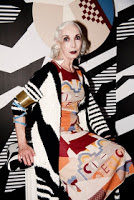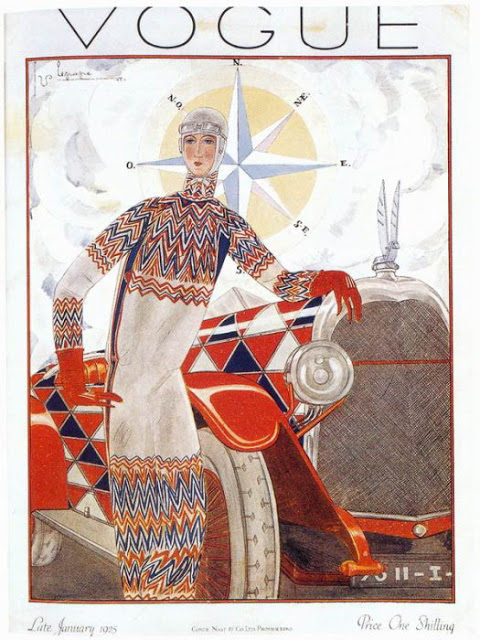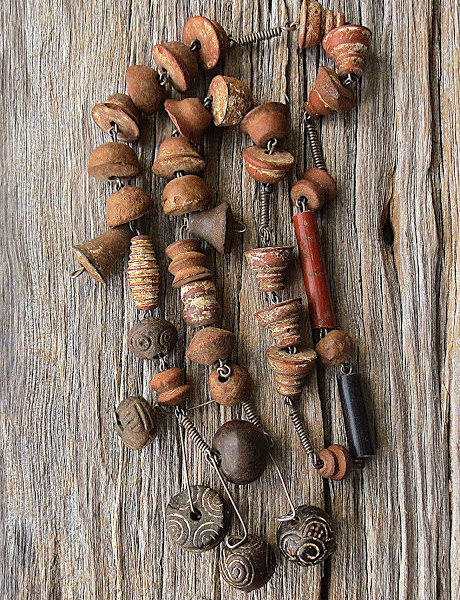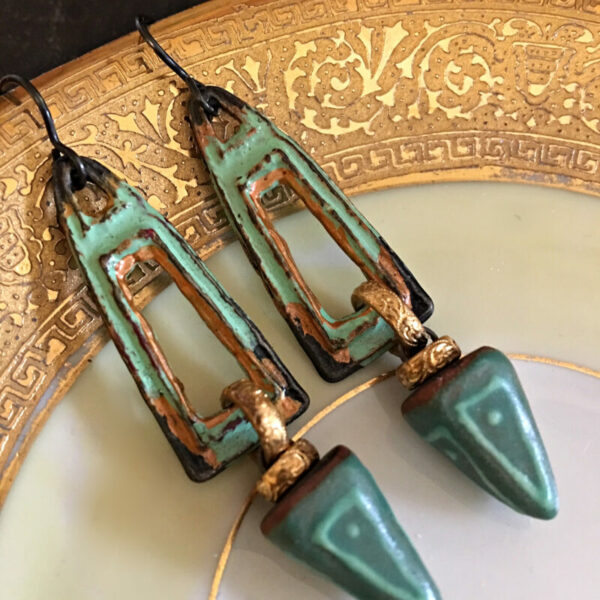Vogue Cover
Simultaneous Dress next to the Simultaneous Car
by Sonia Delaunay
Illustrated by George Lepape from January 1925
Simultanism is the strand of Orphism practised by the Delaunays. The name comes from the work of French scientist Michel Eugène Chevreul who identified the phenomenon of ‘simultaneous contrast’, in which colours look different depending on the colours around them. For example, a grey will look lighter on a dark background than it does on a light one. The Delaunays dispensed with form and aimed to created rhythm, motion and depth through overlapping patches of vibrant hues.

Sonia Delaunay (November 14, 1885 – December 5, 1979) was a Ukrainian-born French artist, who spent most of her working life in Paris and, with her husband Robert Delaunay and others, cofounded the Orphism art movement, noted for its use of strong colours and geometric shapes. Her work extends to painting, textile design and stage set design. She was the first living female artist to have a retrospective exhibition at the Louvre in 1964, and in 1975 was named an officer of the French Legion of Honor.
Her work in modern design included the concepts of geometric abstraction, the integration of furniture, fabrics, wall coverings, and clothing.
Sarah Ilinitchna Stern was born on 14 November 1885 in Hradyzk, then Ukraine was part of the Russian Empire. At a young age she moved to St. Petersburg, where she was cared for by her mother’s brother, Henri Terk. Henri, a successful and affluent Jewish lawyer, and his wife Anna wanted to adopt her but her mother would not allow it. Finally in 1890 she was adopted by the Terks. She assumed the name Sonia Terk and received a privileged upbringing with the Terks. They spent their summers in Finland and traveled widely in Europe introducing Sonia to art museums and galleries. At 18 she attended the Academy of Fine Arts in Karlsruhe. She studied in Germany until 1905 when she decided to move on to Paris.
She came to Paris 1906 to join the emerging avant-garde. She met and married the artist Robert Delaunay, with whom she developed ‘Simultaneism’ – abstract compositions of dynamic contrasting colours and shapes. Her work expressed the energy of modern urban life, celebrating the birth of electric street lighting and the excitement of contemporary ballets and ballrooms.
She artist dedicated her life to experimenting with colour and abstraction, bringing her ideas off the canvas and into the world through tapestry, textiles, mosaic and fashion. Delaunay premiered her first ‘simultaneous dress’ of bright patchwork colours in 1913 and opened a boutique in Madrid in 1918. Her Atelier Simultané in Paris went on to produce radical and progressive designs for scarves, umbrellas, hats, shoes and swimming costumes throughout the 1920s and 1930s. Clients included the Hollywood star Gloria Swanson and the architect Erno Goldfinger, as well department stores like Metz & Co and Liberty. Delaunay’s designs presented her as a progressive woman synonymous with modernity: embroidering poetry onto fabric, turning her apartment into a three-dimensional collage, and creating daring costumes for Diaghilev’s Ballets Russes.
There are diverse inspirations behind Delaunay’s work, from the highly personal approach to colour which harked back to her childhood in Russia, to the impact of her years in Spain and Portugal. Her inspiration provided by modern technology throughout Delaunay’s career, from the Trans-Siberian Railway to the aeroplane, and from the Eiffel Tower to the electric light bulb. Sonia designed a vast seven-metre murals Motor, Dashboard and Propeller, created for the 1937 International Exposition in Paris.
Following her husband’s death in 1941, Sonia Delaunay’s work took on more formal freedom, including rhythmic compositions in angular forms and harlequin colours, which in turn inspired geometric tapestries, carpets and mosaics. Delaunay continued to experiment with abstraction in the post-war era, just as she had done since its birth in the 1910s, becoming a champion for a new generation of artists and an inspiring figure for creative practitioners to this day.
***Beads strung on a chain, by themselves and beads simply added to wire or cord will not be accepted.***
Please add the tag or title FEB ABS to your photos. Include a short description, who created the art beads and a link to your blog, if you have one.
ENTRIES for ART BEAD ARTISTS!!
Monthly Challenge Recap
• From all the entries during the month, an editor will pick their favorite design to be featured every Wednesday here on ABS, so get those entries in soon.




Karen Z
February 3, 2016 at 1:40 pmpssst… under"how to enter", #3… shouldn't that be FEB ABS?
Tari of ClayButtons.com
February 3, 2016 at 6:26 pmThank you Karen. I fixed it!